#litmus paper
Text
Less accurate values can be obtained using pH paper (figure 11.6), while blue and red litmus paper is used only in a qualitative manner to determine whether a solution is acidic or basic.

"Chemistry" 2e - Blackman, A., Bottle, S., Schmid, S., Mocerino, M., Wille, U.
#book quotes#chemistry#nonfiction#textbook#ph test#ph paper#colorimetric test#litmus paper#litmus test#acidic#basic
0 notes
Text
litmus paper is used to indicate the acidity or alkalinity of a substance. Blue litmus paper turns red under acid conditions, and red litmus paper turns blue under alkaline conditions. Read the blog for more information about litmus paper.
0 notes
Text
Paper that literally goes "if you commit violent enough hate crimes toward queer people you actually create more allies =)" is now going to APSR, during pride month, and I have officially given up on political science
#how is no one horrified#academia#tw homophobia#tw queerphobia#polsci#this paper is my litmus test to see which political scientist still has a shred of interest in ethics and philosophy and research
5 notes
·
View notes
Text
mina with vitaligo is so important to me
#except her skin is pinnk and blue#like when u use litmus paper!!#her skin is pink bc its got acid on it all the time but her skin gets patchy bc she starts working on making her acid more basic so its safe#around like kids n crap and she starts turning blue#kirishima and denki think shes sick and sero's like wouldn't she be turning green of she was sick''#bakugo and momo are the only ones that realise what's happening#izu thinks its so fucking cool and he starts asking soo many questions and asking if she can test some stuff out and let him analysis it#ochako and toru think it's super pretty and ask if she can control it to give herself pretty markings on her skin and have her try to make#stars and hearts
6 notes
·
View notes
Note
all of you saying gerard's pussy would stink like that's a bad thing are cowards. if the pussy isn't noxious and a 2 on the pH scale i do not want it.
.
15 notes
·
View notes
Text


Pine Twig and Litmus Paper!
Pine Twig is a plucky young adventurer that hails from Greenlock, who set off from her home one day in hopes to explore all of Objectopia. She has met many friends and enemies, but none of the obstacles she's faced so far have managed to keep her down.
She likes learning new things, creative writing, and all-dressed potato chips.
Litmus Paper is Pine Twig's best friend who accompanies her on her travels throughout Objectopia. The heart of the duo, he is very kind and sweet to the people around him, always being there to lend a helping hand.
He likes tower defense games, fishing, and pumpkin cheesecake.
#look at my art boy#adventures in objectopia#object ocs#pine twig (object oc)#litmus paper (object oc)
2 notes
·
View notes
Text
Halfway through the year and halfway through the summer semester, perfect time to start playing the mountain goats ‘This Year’ on repeat
#I quite literally did that while writing my literature review for my indexing class in December#the only real paper I’ve had to write for grad school so far#the rest of my classes have been project based or just plain jokes#anyway the litmus test for Am I At The End Of My Rope is when I start binge listening to a single song
1 note
·
View note
Text
0 notes
Text
i can tell when i'm sleepy besides from the feeling when i get really focused on something stupid
like.... acids and bases have two different faces.... two different personalities....
1 note
·
View note
Note
how do i know what’s right?
i feel like i have zero critical thinking skills ;-;
a lot of the time when someone poses an idea or a theory they think they’re right, and so they use language that enforces that. but then someone refutes it, and uses language affirming what they believe and i see the point in their argument. and then it gets refuted again and again and again and im just confused.
hi great question. i would love it if there were a single easy litmus test to figure out who's 'right' and whose info i should trust! unfortunately things are rarely this easy, and it's actually completely normal to be overwhelmed by the amount of information being produced and shared, especially when it comes to topics you haven't researched/lived/etc. for most of us, this will be most topics!
i'd preface this by saying that i think your overall attitude here is actually a good one. you're framing it in a pretty self-deprecating way—but actually, imo this type of openness to discussion and disagreement is a really good place to start, esp when dealing with topics that are new to you. nobody enters a contentious debate with a fully fledged, defensible viewpoint. you might feel like you're just treading water here, making no progress toward being able to evaluate arguments for yourself, but i highly doubt that's true.
all of that said: while i again cannot give you a single litmus test for figuring out what's 'right', there are four pretty basic sets of questions that i automatically run through when encountering a new idea, source, topic, or argument: we can call these origin, purpose, value, and limitations.
origin: who's the author? do they have any institutional affiliations? who pays their salary? is this argument or paper funded in any way? is the argument dependent upon the author's social position or status (race, class, etc) and if so, are those factors being discussed clearly? does the author have ties to a particular nation-state or stakes in defending such a nation-state? what's the class character of the author and the argument? what's the social, economic, and intellectual context that gave rise to this argument or source?
purpose: why is this source or person disseminating this information or making this argument? are they trying to sell you anything? are their funders? are they trying to persuade you of a particular political viewpoint? keeping in mind the answers to the 'origin' questions, are there particular ideological positions you would expect to find in this source or argument, and are they present? what are the stakes for the author or source? what about for those who cite the source or further disseminate or publish it?
value: what does this source or argument accomplish well? what aspects of the argument are new to you and strike you as insightful? are there linkages being made that you haven't encountered elsewhere, and that you think are effectively and sufficiently defended? are there statistics or empirical data that might be useful to you in forming your own argument, even if you disagree with how this source or author is interpreting them? what does this argument or source tell you about the types of debates being had, and the rules of those debates?
limitations: where does this argument or source fail you or fall apart? are there obvious rhetorical fallacies you can identify? is the author forgetting or overlooking some piece of information that you know of from elsewhere? which viewpoints may be omitted? keeping in mind the answers to the 'purpose' questions, if this source is defending a particular ideology or political position, is that one you agree with? is it only defensible so long as the author omits or distorts certain pieces of information? are there points where the argument jumps from evidence to a conclusion that the evidence can't fully support? are there alternative explanations for the evidence?
over time you will often find that it becomes more and more automatic to ask yourself these questions. you will also find that the more you read/hear about a particular topic, the faster you can determine whether someone is presenting all of the evidence, presenting it fairly, and using it to fully defend the argument they ultimately want to make. and you will probably also find that at some point, you're able to synthesise your own argument by pulling the strong parts from multiple other people's viewpoints, combining them with your own thinking, and fitting them together in a way that adequately explains and materially analyses the issue at hand.
#sry if this feels kind of abstract lol fight between specificity and applicability#lit and literacy
2K notes
·
View notes
Text
Some Thoughts on the importance of physical touch and connection for the Hells: A reflection on the new animated intro.
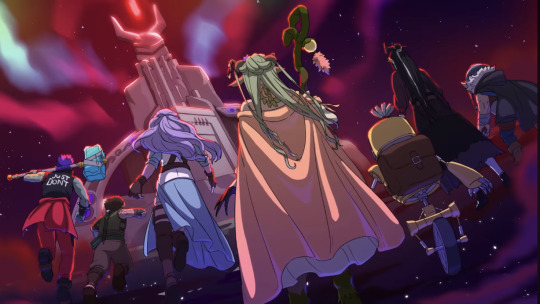
In general, I think the Hells are a really strange and special group, especially for a dnd party. They pretty much laid all their baggage on the table within the first week of meeting each other (What the Fuck is Up With That?) almost as a litmus test: "hey, here's all the shit that comes with being me, last chance to run away if that's too much."
and none of them did. and they all kept choosing to stay, even as shit got even weirder and more and more disturbing answers came to light. I think that continued choice from all of them - to stay - is what makes the bonds between the Hells so deep and so special.
okay trauma analysis and party dynamics is a DIFFERENT POST but it was all RELEVANT INTRODUCTION bc the CHOOSING TO STAY and the KNOWING EACH OTHERS' SHIT are like. key components to understanding why I am so feral about this. okay hopefully you will understand. the body of my essay is below. it has pictures. it got... too long. so. it went under a read more. yw. anyway click below if you want a very detailed analysis of an animated intro that is literally only one minute and thirty seconds long
For the first bit, character intros for Fearne, Orym, Imogen, Ashton, there’s no physical contact.
BUT. First intro of hells as a team. Ashton Trauma Flashback interrupted by laudna approaching slowly from beside him with her hand gently in front of him to signal her presence without startling him, and THEN just talking at them. Bringing him out of those flashbacks. Reminding him where he is and who he’s with.
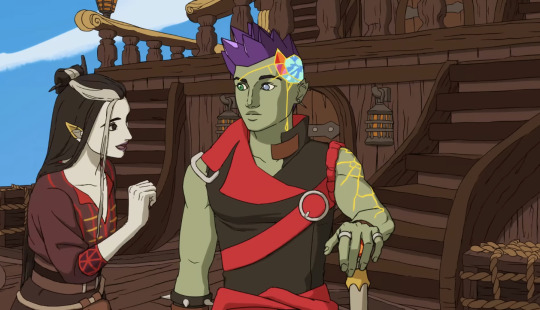
And tbh? For Ashton? Touch is always iffy, so this is almost a more understanding and kind way to bring them out of the flashback. Just physical presence is good! UNLESS. (unless) first actual touch. Fearne stealing their coin purse, so gently that they don’t even notice it (FLIRTING THROUGH THEFT callowmoore my beloved)
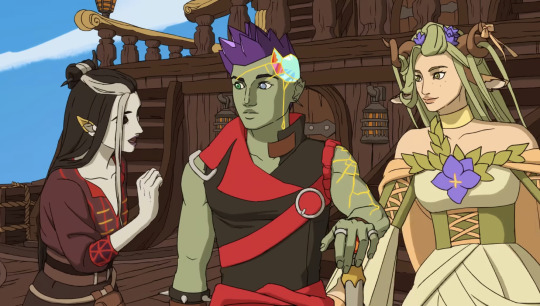

(also grabbed the cap that shows her with his coinpurse these fucking ANIMATORS)
okay pt 2 FLYING OFF THE AIRSHIP

Ashton's first instinct and priority is grab laudna’s hand bc he KNOWS she is made of paper mache and he is ALWAYS watching out for her out of the corner of his eye bc she is breakable and he’s not gonna let her break bc he KNOWS what it’s like to be breakable and need someone to catch you when you’re falling but ANYWAY. he grabs her he uses his hammer as a fulcrum to throw her at Imogen


because OF COURSE he knows that the safest and most comfortable space for laudna is in imogen’s arms. and the two of them wrap their arms around each other and hold tight Superman style bc ofc they do and once laudna is in imogen’s arms she’s absolutely delighted by this whole situation bc OFC SHE IS


(tf do you mean I can’t add more than ten images on mobile UGH fine I’ll finish writing then draft and move to PC the images are IMPORTANT TO MY POINT anyway insert lesbians here) (note from future mind: I have decided that these pic descriptions i left for myself to grab the right images are fucking hilarious so they’re staying in yw)
Then fearne (who had been on her way in that direction already) swoops under Ashton to catch him as he flips over from the momentum so he can land on her giant bird back and she can fly him away.
(Pics: It’s fine to touch Ash if you’re saving their life)


(also not pictured: chet staying on the ship but losing his hat, orym grabbing it out of the air, imogen casting fly on fcg right before she catches laudna, fcg flying over to grab orym) All of this happens in six seconds by the way. One round of combat. These animators are fucking incredible.
BACK TO CHARACTER INTROS laudna who is ofc alone and in the dark at the bottom of the Sun tree, reliving her past…
(Pic: sad lonely laudna)

right up until Imogen puts her head on her shoulder, and the darkness burns away into light. She doesn’t say anything, or talk with laudna - all it takes is that physical reminder that she’s not alone anymore, that there is warmth, that she is surrounded by a family who loves her so much they chose to turn down comfortable beds in a lord’s manor so that they could join her in sleeping at the bottom of the Sun Tree. (Fav lil detail - fearne wrapped around Orym like he’s a teddy bear, and holding tight to laudna’s blanket to make sure she can’t go anywhere.)
(Pics: THE POWER OF LESBIANS AND FOUND FAMILY)



fcg. Fuck. Starts with their flashback, with their red eyes and their buzzsaw, but almost immediately we see Ashton reach out to grab their shoulder and Orym whip out a vine to tie up their saw.
(pics: reaching out even if it might hurt youuuuu)
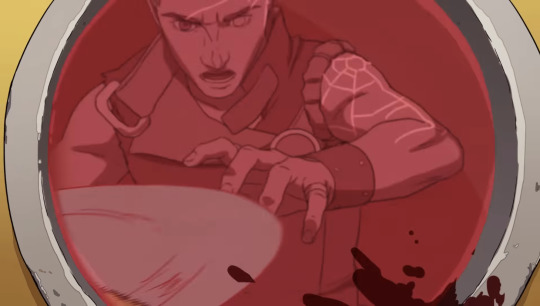
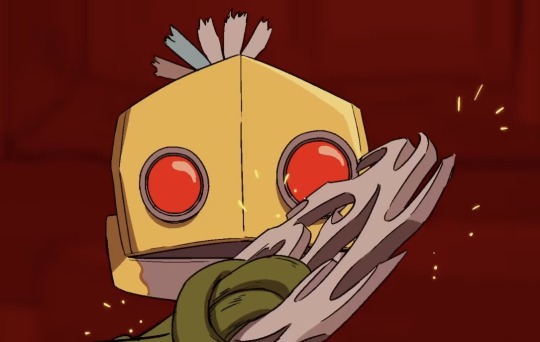
Imogen goes on her knees and wraps her arms around FCG’s other side, and the rest of them all gather around him, holding him to keep him and each other safe, but mostly just grounding him in the present by surrounding him physically until the flashback fades and he’s once more aware of his surroundings.
(Pics: what the fuck they just need to be held)
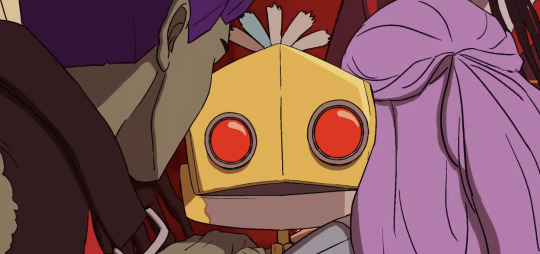
(once shit has calmed down fearne uses this opportunity to pick Ashton’s pocket again. Flirting through theft).
(Pic: fearne is a menace to society)

final fight scene. fuck yes.
(Pic: IT’S THURSDAY NIIIIIIIIIIIGHT)

This is mostly just giving all of them room to be badasses (as they deserve) - but there are some things!! First!!
(pics: THESE WITCHES BE BITCHES minus fearne sry fearne we miss u but you are on fire and laudna is made of wood currently)


Imogen and laudna casting spells back to back, trusting each other to take care of what’s on their side. Inseparable, even in a battle where their party has scattered to fight other enemies.
BUT. The BIG thing though in this sequence. Maybe my favorite part? Idk I don’t have a favorite. But!! Orym. taking out four of Otohan’s shadow knights. then facing off against her personally!! And it’s one-on-one, because this was Orym’s task alone - to find the person who attacked his leader and killed his family. He’s angry, but mostly he’s honed-in and focused and determined. This is his mission.
(Pics: WHO’S JUST A LIL GUY NOW HUH)



But then, when Otohan pushes him back…
(Pic: fuck. shit. fuck. im. fine. anYway. them.)

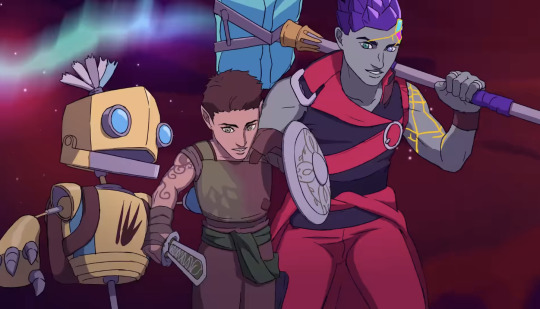
FCG and Ashton are there right behind him, and they put their arms out and catch him so he doesn’t fly back any farther. And there’s this look of surprise on his face, because once he lost Will, he never expected there to be anyone else standing behind him, ready to catch him. And yet, here they are.
(Pics: fuck yes fuck yes fuck yes GOOOO ORYM!!!)

They give Orym a push forward and follow behind him, and he walks back towards Otohan with confidence. Lil grin on his face, brisk walking pace - he even does a little fancy sword swoosh! Because maybe he’s not strong enough to take out Otohan on his own. But the thing is, he’s not alone anymore.
(Pic: THEY.)
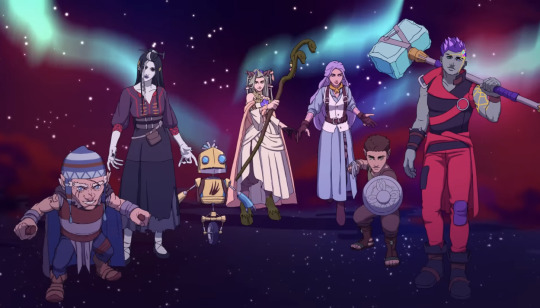
None of them are alone. And whenever any of them forget, or slip into old habits and memories, the rest are right there to reach out a hand to remind them.
Building a family out of broken pieces is difficult even without an apocalypse. But the Hells have shown each other, over and over and over, often with their actions even more than their words, that they really are dedicated to this family that they've built together. This intro fucking slaps so hard and the animators deserve so much praise for how incredible this intro is
#Tbh I could (and probably will) write multiple essays on the new intro but this is the one I love the most#no I’m not touch-starved what are you talking about#critical role#bells hells#c3e76#cr3#c3#cr3 spoilers#c3 spoilers#bells hells intro#ashton greymoore#laudna#fearne calloway#imogen temult#fcg#orym of the air ashari#chetney pock o'pea#bells hells animated
310 notes
·
View notes
Text
litmus paper is used to indicate the acidity or alkalinity of a substance. Blue litmus paper turns red under acid conditions, and red litmus paper turns blue under alkaline conditions.
0 notes
Text
So much of Beau is Afraid is representative of the way in which prolonged childhood trauma creates a gap between your internal and external self. This movie is set within that gap and displays this jagged distorted image of Beau’s reality. Beau isn’t sure what’s real or fake because he has absolutely no litmus test with which he can determine reality. Not only in the context of “what is actually happening”, but also in the context of “how does he feel about it?” and “how does Beau fit into any of it?” - y’know?
It’s such an interesting approach to the dissociation of the self, while also having to EXPERIENCE the self. The confusion it causes, the sense of being adrift, the desire to be guided but also the absolute uncompromising resistance to it.
Beau trusts no one, but trusts himself the least. Only he knows his own lived experience, and he’s defensive of it when challenged, but without a challenge he’ll fold like a wet paper bag because he’s heard endlessly about how wrong he is. He is CONSTANTLY asking for direction and validation, but cannot trust it once he receives it, either because people don’t know his true face, or because once they know his true face they are capable of manipulating him with it. Nobody understands his intentions or motivations, least of all himself! If something happens, it is both his fault for being a terrible person, and not his fault because everyone is misunderstanding him! Absolutely nothing is concrete except for the fact that his mother has micromanaged his life and lied to him, yet he loves and depends on her.
It’s cPTSD the movie.
574 notes
·
View notes
Text
do i have an unhealthy obsession with buzzcut boys my whole life? maybe. maybe i do. and so what. if anything, it’s very logical. the buzzcut is a litmus paper that tells you if the boy is truly pretty or is it just. you know. the hair. remove the hair and what will be left? either The True God-like Beauty or nothing at all.
#ronan lynch#i made this post for you my favourite insufferable child#and for the bunch of other boys maybe 👀#michael scofield#prison break#sam halse#summer sons#ryunosuke tanaka#haikyuu#trc#the raven cycle
195 notes
·
View notes
Text
For a decade, the husband of Michelle Bulang, a 44-year-old mother of four, made her life hell. He drank and gambled, failing to provide for her or their four children, even as he forbade her to work. He was also regularly abusive “physically, emotionally, verbally, and sexually,” Bulang said, choking back tears. Once, he poured boiling water all over her—her back and legs still bear the scars.
Bulang has since escaped the relationship and not seen her abuser in years, but on paper she is still married to him. The overwhelming power of the Catholic Church in the Philippines means divorce is not legal. That might be about to change. A divorce bill has passed the House of Representatives and faces the Senate, as the power of the church wanes.
“There are two policies which are seen as a litmus test of Catholic influence. The first is abortion, which is forbidden in the Constitution. And the second is divorce,” said Manolo Quezon III, a former speechwriter for Philippine President Benigno “Ninoy” Aquino Jr. There are only two countries in the world where divorce is still not legal—the Vatican City and the Philippines. Other heavily Catholic nations legalized the practice long ago, such as Ireland in 1995 and Spain in 1981. But the lingering influence of the church in a country where nearly 80 percent of the population is Catholic is proverbial.
Yet, from 1917 to 1949, divorce was legal in the Philippines. The right was only abolished in 1949 as U.S. control ended and the anti-clerical legacies of the Philippine Revolution faded. Under the dictatorship of Ferdinand Marcos Sr., the church became a locus for democratic opposition—even as the president was rumored to keep a divorce bill in his desk to brandish at bishops during meetings when he wanted to keep them in line.
The 1986 People Power Revolution that saw the end of Marcos also saw the peak of church authority. The revered Cardinal Jaime Sin, archbishop of Manila, called people to the streets to protest a rigged election. The Philippines faced a potential Tiananmen moment as tanks rolled. But they stopped as nuns praying the rosary knelt in front of the troops and crowds linked their arms behind them. Marcos fell and fled into exile. The new President Corazon “Cory” Aquino, known for her devotion, inaugurated a new constitution that enshrined democracy, banned abortion, and committed to preserving the family.
Those days are fading. “There is a realization that the Philippines is a secular state, and it should not be subscribing to church principles or doctrines, which we respect but not must not control the policymaking processes,” said Rep. Edcel Lagman, who has helped spearhead the divorce bill. On May 22, the bill narrowly passed the House of Representatives with 131 votes in favor, 109 against, and 20 abstaining.
Under the current system, Muslims, who make up about 5 percent of the country’s population, are allowed to divorce. For Christians, their options are to either having their marriage annulled through a civil court, modeled on the Catholic process—reasons including bigamy, psychological incapacity at time of marriage, or use of fraud or threats—or filing for separation—reasons including physical abuse, adultery, abandonment, homosexuality, and drug addiction and alcoholism. The new bill would allow people who currently seek separation for these reasons to now simply seek divorce.
The inadequacies of this system are well understood. It is both extremely expensive and very slow-moving, leaving victims, usually women, trapped in marriages to monsters. Stella Sibonga, a 47-year-old mother of three, has had nothing to do with her husband for decades. Dug out of hiding and marched to the altar after he got an 18-year-old Sibonga pregnant, he took his vows drunk and proceeded to abuse Sibonga and the children she bore. Out of despair, she twice attempted suicide. Later, he tried to kill her and her children with a machete.
In 2005, at age 27, Sibonga left him, and in 2012 she initiated legal proceedings to have her marriage declared null on the grounds of her husband’s “psychological incapacity.” In 2017, a judge ruled in her favor, but the Office of the Solicitor General, charged by the government with upholding marriage, appealed and won in 2019. The case is still ongoing. Sibonga estimates that it has cost her around 300,000 pesos—over $5,000—to pursue the case. This more than most Filipinos will earn in a year. Her experience of the court system is not unusual.
Those who would reform this system smell victory but are treading carefully, keen to reassure the potentially uncertain. “We sympathize with the concern of some of the conservatives as some states have given divorce a bad name. So they don’t want us to have a Las Vegas type of divorce,” said Paul Roxas, an activist with the Divorce Pilipinas Coalition. A recent poll showed that that exactly 50 percent of Filipinos supported divorce among irreconcilably separated couples, with 31 percent opposed and 17 percent undecided.
Navigating the Senate will be tricky. A divorce bill previously passed the House in 2018 but languished in the Senate. So far, at least seven of the Philippines’s 24 senators have are thought to be in favor of the bill. But four have voiced opposition to the bill, and another 8 have previously made statements against divorce. Still, Roxas is optimistic: “A significant proportion of the senators are sort of fence-sitting.” The Divorce Pilipinas Coalition is lobbying hard those they feel are persuadable and has staked out fall back concessions like only allowing people to divorce once in their lifetimes.
Should the bill pass, it will be the fourth big defeat the Catholic Church has faced in 12 years. In 2012, the Philippine government legalized contraception in the face of furious opposition from the church. In 2016, the presidency was won by Rodrigo Duterte, a man who cursed the pope during his campaign. Church condemnations of the man and the extrajudicial killings that took place in his “war on drugs” failed to dent his enormous popular support. And in 2022, the church all but openly opposed the candidacy of Ferdinand “Bongbong” Marcos Jr., son of the former dictator. Nonetheless, backed by Duterte, he romped home to victory.
With each defeat, wariness of church power seems to have faded. “In the Philippines, there is no Catholic vote—in other words, we should not be afraid of any reprisal from the Church during the elections,” Lagman said. Indeed, he claims that private polling shows that congresspeople who endorse the divorce bill actually stand to receive a bump in support.
Father Jerome Secilliano, rector of the EDSA Shrine built to commemorate the People Power protests, says things very different from 1986. “People were already exasperated with the government” when cardinal sin made the call, he says. Now, according to Seciliano, people are “exasperated” with a church they don’t feel is doing enough for them. “Let’s admit it we don’t have the resources to provide for the people,” he said. “We are a poor country, there are so many poor people, and poor people expect too much from you.” Instead, they turn to politicians who can offer patronage, cash, and practical solutions. “And people have more practical needs than the Mass.”
Cultural change is also part of the story. Gone are the days of Seciliano’s boyhood when he would press his forehead to the hand of elders and all heard the Angelus toll at 6 o’clock every evening. “When we talk about LGBT in the 1980s, perhaps people will still believe us. But now it’s 2024—because of the many different opinions offered, it’s now very politically incorrect to even call him homo or gay.” Indeed, the Philippines is already strikingly accepting of homosexuality for a Catholic country, and polling shows that young Filipinos are among the most likely to support the divorce bill.
Not all the cultural change is necessarily inimical to the church. Pentecostal and born-again Christians are making big inroads among the Philippines. Theological differences between Catholics and these groups that once caused bloody wars now fade as these churches make common cause on promoting socially conservative Christian values. One prominent opponent of the divorce bill, Sen. Emmanuel Villanueva, is the son of Eddie Villanueva, a former politician who founded The Jesus Is Lord evangelical megachurch.
Still, it’s not always so simple as that says Joseph Bonifacio, a former pastor with Victory Church, another evangelical megachurch. These non-Catholic churches are less monolithic in their attitudes. “This allows for other voices, including more liberal ones.” A recent statement by the Philippine Council of Evangelical Churches expressed opposition to the divorce bill, stating a preference instead for expanding grounds for annulment to dissolve the marriage. Given that the grounds for annulment are, with some caveats, close the grounds on which the current bill would grant divorce, the differences seem largely cosmetic.
The Catholic Church is trying to regroup. “The church needs to become a church of the poor,” Father Tito Caluag said. As the man who gives the evening Mass on ABS-CBN, the Philippines’s largest media conglomerate, he is perhaps the closest the Catholic Church has to a celebrity priest. Caluag is trying to take on this task himself reorganizing the church’s charitable efforts talking about professionalization, data analysis, and new fundraising that reduces reliance on single ultrawealthy donors. Notably past polls suggest the working poor are among those most likely to support divorce. Yet it is hard not to notice that the interview is taking place in the Village, one of Manila’s ultraexclusive gated neighborhoods. Caluag explains it was donated by a pious socialite, now deceased, and wryly accepts the irony.
Other tensions will be hard to solve, too. The church must also be a listening church, Caluag says, invoking the words of Pope Francis. “And we must genuinely listen. Because I’ve heard young people say we’ve talked our so-and-so, and he listened, but at the end of it all, he said was the same thing like nothing had happened.”
But he remains opposed to divorce—as doctrine requires all Catholic priests must be. For stories like Sibonga’s and Bulang’s, however, the church seems to have few answers.
39 notes
·
View notes